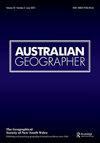A whole-of-community approach: local community responses to refugee settlement–integration in rural Australia
IF 2
2区 社会学
Q2 GEOGRAPHY
引用次数: 0
Abstract
Humanitarian migrants are moving to rural areas in Australia in increasing numbers, where it is often local communities who take responsibility for their settlement–integration. Current models acknowledge that settlement–integration is a two-way process between humanitarian migrants and the rural community but remain overly focused on the actions of humanitarian migrants while neglecting the conditions of rural communities. This article discusses the case study of a rural Australian town where humanitarian migrants, Hazaras from Afghanistan, have settled over the past decade. We draw on Jenny Phillimore’s ‘Five domains of opportunity structures’ model of settlement-integration – locality, discourse, relations, structure and initiatives and support – to explore how local government, the mayor and volunteer refugee/migrant support groups facilitate a welcoming community. The case study provides evidence for Phillimore’s ‘opportunity structures’ as effective conditions for positive humanitarian migrant settlement–integration in a rural context. Through the lens of Phillimore’s opportunity structures, we operationalise a Whole-of-Community concept in the context of rural humanitarian settlement–integration.整个社区方法:澳大利亚农村地区当地社区对难民安置一体化的反应
越来越多的人道主义移民正在向澳大利亚的农村地区迁移,在那里,往往是当地社区负责他们的定居和融入。目前的模式承认定居融合是人道主义移徙者和农村社区之间的双向过程,但仍然过分注重人道主义移徙者的行动,而忽视了农村社区的条件。本文讨论了一个澳大利亚乡村小镇的案例研究,在过去的十年里,来自阿富汗的人道主义移民哈扎拉人在这里定居。我们借鉴Jenny Phillimore的“五个领域的机会结构”定居整合模型——地点、话语、关系、结构、倡议和支持——来探索地方政府、市长和志愿者难民/移民支持团体如何促进一个欢迎社区。该案例研究为Phillimore的“机会结构”提供了证据,证明它是农村环境下积极人道主义移民定居融合的有效条件。通过Phillimore的机会结构,我们在农村人道主义安置整合的背景下实施了一个“社区整体”的概念。
本文章由计算机程序翻译,如有差异,请以英文原文为准。
求助全文
约1分钟内获得全文
求助全文
来源期刊

Australian Geographer
GEOGRAPHY-
CiteScore
4.10
自引率
8.30%
发文量
33
期刊介绍:
Australian Geographer was founded in 1928 and is the nation"s oldest geographical journal. It is a high standard, refereed general geography journal covering all aspects of the discipline, both human and physical. While papers concerning any aspect of geography are considered for publication, the journal focuses primarily on two areas of research: •Australia and its world region, including developments, issues and policies in Australia, the western Pacific, the Indian Ocean, Asia and Antarctica. •Environmental studies, particularly the biophysical environment and human interaction with it.
 求助内容:
求助内容: 应助结果提醒方式:
应助结果提醒方式:


